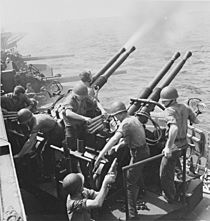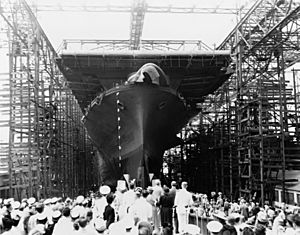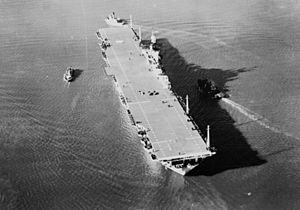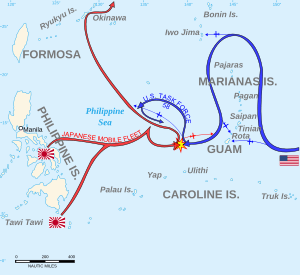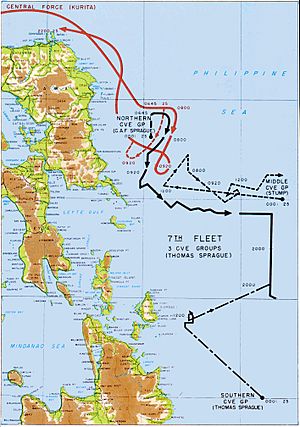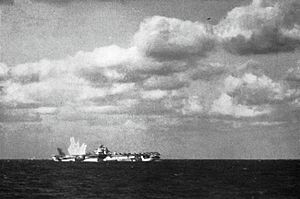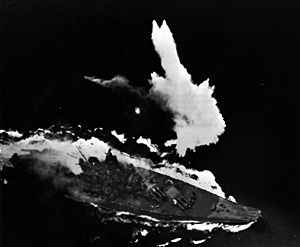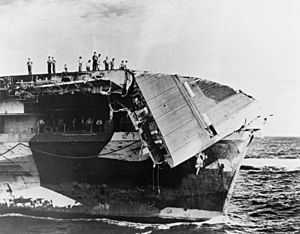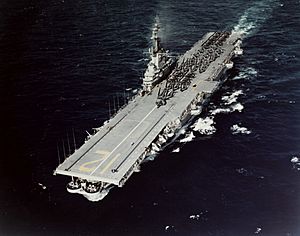USS Hornet (CV-12) facts for kids
class="infobox " style="float: right; clear: right; width: 315px; border-spacing: 2px; text-align: left; font-size: 90%;"
| colspan="2" style="text-align: center; font-size: 90%; line-height: 1.5em;" | 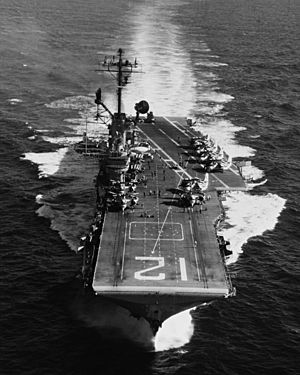
|} The USS Hornet (CV/CVA/CVS-12) was an Essex-class aircraft carrier built for the United States Navy during World War II. She was finished in late 1943. The Hornet joined the main attack force in the Pacific Ocean during the Pacific War. In 1944, she helped attack Japanese bases in New Guinea, Palau, and Truk.
The Hornet also took part in the Mariana and Palau Islands campaign. She was part of the Battle of the Philippine Sea in June 1944. This battle was called the "Great Marianas Turkey Shoot" because so many Japanese planes were shot down. Later, she fought in the Philippines Campaign and the Volcano and Ryukyu Islands campaign in 1945. She was damaged by a huge storm (typhoon) in June 1945 and had to go back to the United States for repairs.
After the war, the Hornet helped bring troops home in Operation Magic Carpet. She was put into reserve in 1946. The ship was brought back into service during the Korean War (1950–1953). She was updated to handle jet-propelled aircraft. In the late 1950s, she was updated again to become an anti-submarine carrier. The Hornet also played a small role in the Vietnam War in the 1960s. She was famous for picking up the Apollo 11 and Apollo 12 astronauts after they returned from the Moon.
The Hornet was taken out of service in 1970. Today, she is a National Historic Landmark and a California Historical Landmark. She opened to the public as the USS Hornet Museum in Alameda, California, in 1998.
Contents
| History | |
|---|---|
| Name | Hornet |
| Namesake | Hornet |
| Ordered | 20 May 1940 |
| Awarded | 9 September 1940 |
| Builder | Newport News Shipbuilding, Newport News, Virginia |
| Laid down | 3 August 1942 |
| Launched | 30 August 1943 |
| Commissioned | 29 November 1943 |
| Decommissioned | 15 January 1947 |
| Renamed | From Kearsarge, October 1942 |
| Identification | Hull number: CV-12 |
| Recommissioned | 11 September 1953 |
| Decommissioned | 26 June 1970 |
| Reclassified |
|
| Stricken | 25 July 1989 |
| Status | Museum ship at the USS Hornet Museum in Alameda, California |
| Badge |  |
| General characteristics (as built) | |
| Class and type | Essex-class aircraft carrier |
| Displacement | |
| Length | |
| Beam | 93 ft (28.3 m) (waterline) |
| Draft | 34 ft 2 in (10.41 m) (full load) |
| Installed power |
|
| Propulsion | 4 × shafts; 4 × geared steam turbines |
| Speed | 33 knots (61 km/h; 38 mph) |
| Range | 14,100 nmi (26,100 km; 16,200 mi) at 20 knots (37 km/h; 23 mph) |
| Crew |
|
| Sensors and processing systems |
|
| Armament |
|
| Armor | |
| Aircraft carried | 91–103 aircraft |
| Aviation facilities |
|
| Reference #: | 91002065 |
| Designated: | 1991 |
| Designated: | 1999 |
| Reference #: | 1029 |
- Early Pacific Operations
- Fighting in the Mariana and Palau Islands
- More Attacks in the Pacific
- Liberating the Philippines
- Volcano and Ryukyu Islands Campaign
Building and Features of the Hornet
The Essex-class ships were much bigger than earlier aircraft carriers. This allowed them to carry more planes, armor, and weapons. The Hornet was about 888 feet (271 meters) long. She was 93 feet (28 meters) wide.
The ship weighed about 27,100 tons when empty. She had a crew of about 268 officers and 2,362 sailors. By 1945, her crew grew to 382 officers and 3,003 sailors. The Hornet had four powerful steam engines. They could make the ship go as fast as 33 knots (61 km/h). She could travel about 14,100 nautical miles (26,100 km) without needing to refuel.
Flight Deck and Aircraft

The Hornet's flight deck was 862 feet (263 meters) long. It was 108 feet (33 meters) wide. Below the flight deck was a large hangar. It was 654 feet (199 meters) long and 70 feet (21 meters) wide. The hangar was 18 feet (5.5 meters) tall.
Planes moved between the hangar and the flight deck using three elevators. Two were on the flight deck. One was a special folding elevator on the side of the ship. The Hornet had two catapults to help planes take off quickly. She also had special gear to help planes land safely.
At first, Essex-class ships were meant to carry over 100 aircraft. This included fighters, bombers, and torpedo planes. As the war went on, the number of fighters increased. By mid-1945, the Hornet usually carried about 103 aircraft. This included 36 or 37 fighters, many fighter-bombers, and dive and torpedo squadrons.
Weapons and Protection
The Hornet had many guns to defend herself. Her main weapons were twelve 5-inch (127 mm) guns. These guns could shoot at both ships and planes. She also had many 40 mm Bofors anti-aircraft (AA) guns. These were used to shoot down enemy planes. There were also 46 smaller 20 mm AA guns.
The ship had strong armor to protect her. Her side armor belt was 4 inches (10 cm) thick. It covered the middle part of the ship. The hangar deck and the deck below it also had armor. This armor protected important parts of the ship.
The Hornet used radar to find enemy ships and planes. She had different types of radar. Some were for finding targets far away. Others were for helping the guns aim.
Changes During the War
The Hornet was updated during the war. More 20 mm guns were added. By the end of the war, she had 35 of these guns. When she was repaired in San Francisco in 1945, her radar was improved. Her hangar-deck catapult was moved to the flight deck. Her command center was also made bigger. Ten new 40 mm gun mounts were added. This brought her total to 68 of these guns.
Building and Service History
The Hornet was ordered in May 1940. She was first named Kearsarge. Her keel was laid down on August 3, 1942. Another ship named Hornet was sunk in October 1942. So, this new ship was renamed Hornet shortly after. She was launched on August 30, 1943. The ship was officially put into service on November 29, 1943. Captain Miles R. Browning was her first commander.
The Hornet trained off Bermuda. Then she sailed to the Pacific Ocean in February 1944. She joined Task Force 58, a powerful group of ships.
Early Pacific Operations
In March 1944, the Hornet attacked Japanese bases in the Palau Islands. Her planes also laid mines in Kossol Roads. This was the first and only time carrier planes laid mines in the Pacific War. The Americans sank many Japanese ships and destroyed many planes.
In April 1944, the Hornet attacked airfields in New Guinea. She also attacked Truk, a Japanese naval base. The Americans severely damaged the base. They shot down many Japanese planes.
Fighting in the Mariana and Palau Islands
By June 1944, the Hornets air group had 40 Hellcat fighters and many bombers. Task Force 58 attacked the Marianas in June. Hornets planes shot down many Japanese planes over Guam. They also attacked Japanese convoys.
The Great Marianas Turkey Shoot
On June 19, 1944, the Battle of the Philippine Sea began. Japanese planes attacked the American fleet. The Hornet's fighters helped shoot down many Japanese planes. This battle was nicknamed "The Marianas Turkey Shoot." The Americans shot down 208 Japanese planes. They lost only 31 of their own.
The next day, the Hornet's planes attacked the Japanese fleet. They badly damaged the carrier Zuikaku. Other American planes sank the carrier Hiyō and two oil tankers. Many American planes were lost during night landings, but most crews were rescued.
More Attacks in the Pacific
After refueling, the Hornet attacked the Bonin Islands again in July and August 1944. She helped prepare for the invasion of the Philippines. In September, her planes attacked Japanese bases in the Palaus and Mindanao. They sank many ships and destroyed many planes.
One of Hornet's pilots was shot down near Leyte. Filipino fishermen rescued him. He reported that there were no Japanese soldiers on Leyte. This helped the Americans decide to invade Leyte earlier.
In September 1944, Hornet's planes attacked Manila Bay. They sank a Japanese destroyer. They also sank many oil tankers and cargo ships.
Liberating the Philippines
In October 1944, the Hornet attacked Japanese airfields in the Ryukyus and Formosa. The Japanese lost many planes. The Hornet was almost hit by a torpedo during these attacks.
Battle off Samar
On October 25, 1944, the Hornet was too far away to help American escort carriers that were attacked by Japanese battleships. But her planes did attack the Japanese ships later. The next morning, Hornet's planes attacked the Japanese cruiser Noshiro. They hit her with bombs and torpedoes, and she sank.
After this, the Hornet continued to attack Japanese airfields and ships in the Philippines. In November, her planes sank a heavy cruiser and other ships. They also destroyed many Japanese planes. The Japanese started using kamikaze (suicide) planes. This made the Navy change its air groups to have more fighters.
Typhoon Cobra
In December 1944, the Hornet was part of Task Force 38. They were supporting the invasion of Mindoro. The task force flew many missions over Luzon. But then, they sailed into a huge storm called Typhoon Cobra. Many ships were damaged. The Hornet lost 146 aircraft. Three destroyers were sunk.
South China Sea Raid
In January 1945, Task Force 38 entered the South China Sea. They attacked Japanese airfields and shipping in French Indo-China, Luzon, and Hong Kong. They sank many ships and destroyed hundreds of planes. During this time, kamikaze attacks badly damaged Hornet's sister ship, the Ticonderoga.
Volcano and Ryukyu Islands Campaign
In February 1945, the Hornet attacked the Tokyo area to prepare for the invasion of Iwo Jima. Her pilots shot down many Japanese planes. The Hornet then supported the landings on Iwo Jima.
In March, the Hornet attacked Japanese naval bases. Her planes fought many Japanese fighters. One kamikaze plane crashed close behind the Hornet. Another sister ship, the Franklin, was badly damaged. The Hornet lost 13 planes in combat that day.
The Hornets planes then started attacking Okinawa in March. They sank a convoy of Japanese ships. The Japanese launched huge kamikaze attacks. On April 6, almost 700 Japanese planes attacked. The Hornets fighters shot down many of them. But many American ships were damaged or sunk.
Operation Ten-Go
On April 7, 1945, the Hornets planes attacked the giant Japanese battleship Yamato. The Hornets Avengers hit the Yamato with torpedoes. The Yamato sank less than two hours later. Four Japanese destroyers and a light cruiser were also sunk.
The Hornet continued to support the battle for Okinawa. Kamikaze attacks continued. On June 5, the Hornet sailed into another typhoon. A huge wave crashed onto her bow. It damaged 25 feet (8 meters) of her flight deck. Another ship, the Pittsburgh, lost its bow. Only six men died in the storm, but 76 planes were destroyed.
Even with the damage, the Hornet continued to launch planes. She went home for repairs in July 1945. The Hornet earned seven battle stars for her service in the war.
After repairs, the Hornet helped bring troops home from the Pacific. She was taken out of service on January 15, 1947. She was placed in the reserve fleet.
After the War: 1951 to 1970
The Hornet was brought back into service on March 20, 1951. She was updated to be an attack aircraft carrier. In 1952, her bow was used to repair her sister ship, the Wasp, after a collision. The Hornet was recommissioned on September 11, 1953. She then went on an eight-month trip around the world.
In 1954, the Hornet helped search for survivors of a passenger plane shot down by Chinese aircraft. Her planes helped shoot down two attacking Chinese fighters. She then joined the 7th Fleet in the Far East. She helped evacuate Vietnamese people from the north to South Vietnam.
In 1958, the Hornet was changed into an anti-submarine warfare (ASW) carrier. This meant she specialized in finding and fighting submarines. Her air group included ASW planes and helicopters.
Vietnam and Space Missions
The Hornet was sent to the 7th Fleet many times in the 1960s. She operated near South Vietnam, Japan, and the Philippines. She also played a very important role in the Apollo program. She was a recovery ship for space missions.
In 1965, a helicopter from Hornet flew a world record distance. It flew over 2,106 miles (3,388 kilometers) without landing or refueling. The Hornet was deployed to Vietnam from October 1965 to January 1966. Her planes helped escort other carriers and rescue pilots.
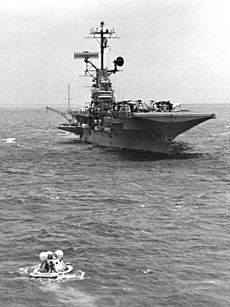
On August 25, 1966, the Hornet recovered the AS-202 Apollo space capsule. This was an uncrewed test flight. The capsule, designed to carry astronauts to the Moon, is now on display aboard the Hornet.
The Hornet returned to Vietnam in 1967 and 1968. In April 1969, she was sent to reinforce American ships after North Korea shot down a US plane.
The Hornet made history on July 24, 1969. She recovered the three astronauts (Neil Armstrong, Michael Collins, and Buzz Aldrin) from the first Moon landing mission, Apollo 11. President Nixon was on board to welcome them. The astronauts stayed in quarantine on Hornet before going to Houston. The Hornet also recovered the Apollo 12 astronauts on November 24, 1969.
Retirement and Museum Ship

The Hornet was taken out of service on June 26, 1970. She was stored in the Puget Sound Naval Shipyard. In 1991, she was named a National Historic Landmark. The ship was given to the Aircraft Carrier Hornet Foundation in 1998. On October 17, 1998, she opened to the public as the USS Hornet Museum in Alameda, California.
The Hornet has been featured in many movies and TV shows. She was in an episode of the TV series JAG in 1997. Scenes from the movie Rescue Dawn (2007) were filmed on board. The Hornet also hosted the final challenge of the reality show The Amazing Race in its thirtieth season.
Awards and Honors
The USS Hornet received many awards for her service.
- Navy Presidential Unit Citation
- Meritorious Unit Commendation with two bronze stars
- China Service Medal
- Asiatic-Pacific Campaign Medal with two silver stars and one bronze star
- World War II Victory Medal
- Navy Occupation Service Medal with 'Europe' Bar
- National Defense Service Medal with one bronze star
- Armed Forces Expeditionary Medal with two bronze stars
- Vietnam Service Medal with three bronze stars
- Philippine Liberation Medal
- Vietnam Campaign Medal with 1960– Device
Images for kids
This article incorporates text from the public domain Dictionary of American Naval Fighting Ships. The entry can be found here.
- USS Hornet (CV-12) at Historic Naval Ships Association
See also
 In Spanish: USS Hornet (CV-12) para niños
In Spanish: USS Hornet (CV-12) para niños


